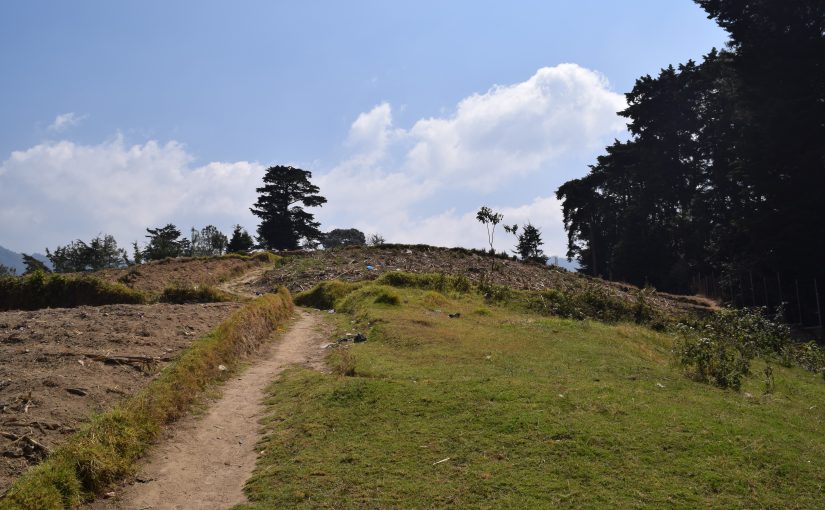As we saw in the previous unit, the direction of actions can be denoted in K’iche’. Verbs can also take on particles that let us know when a verb has a particular direction or movement.
We will take another look at the text from our previous unit, this time focusing on the verbs that have incorporated movement:
UCHUPLINEM JUN ALAJ CH’UMIL
Ronojel ch’aq’ab’ kinka’y aq’an chi la’ chikaj, kinwil apan jun laj ch’umil sib’alaj kachuplinik; utukelam, le uchuplinem kuya jun nimalaj utzil pa le wanima. K’o jun aq’ab’ xinel apan chwach le wo’ch, xinka’y apan chech le nutinamit, xe’nwil apan jun tzob’aj achijab’-ixoqib’ epetinaq, sib’alaj keb’isonik. Aretaq xeq’ax b’i wuk’, xkib’ij kan chwe cher xeb’e chi na chuch’ab’exik ri nimalaj q’atal tzil, are taq xinta wa’ sib’alaj xinb’isonik, ma we ne kech’ay chu’la jumul ja cha ri uk’isb’al mul.
Alaj ch’umil: we ne aweta’m at ri k’axk’olil kuriq we nutinamit, chaya la jub’eq’ ri uchuplinem ri utzil kariqitaj awuk’, na kawaj ta chik kinwil le’qatat-qanan kakiriq k’ax. Kinwachik’aj ri’ ri jun q’ij cher katkowinik katpe wuk’, arech apachin na k’u kaka’y kan pa le wo’ch: kuna’ b’i jub’eq’ utzil, ki’kotemal. Kawaj pa jun q’ij kinb’e awuk’, kate’nwila’; junam koje’xojowa pa ri k’olb’al ja wi xya wi ri achuplinem. Weta’am cher xa rumal sib’alaj naj ri at k’o wi, we ne na kintzalij ta chu’la pa le nutinamit, cherma we na kintzalij ta chu’loq: oj keb’ chi k’ut kaqaya la le uchuplinem ri utzil, ri ki’kotemal chikech ri achijab’, ri ixoqib’, ri eqata-qanan, ri qati’t qamam chuqe ne ri ak’alab’ ri kakitzukuj ri utzil; ma ja cha ri at, ja cha ri in, ja cha ri konojel taq winaq, k’is k’o ri uchuplinem ri utzil ri ki’kotemal pa taq ri uk’ux qanima.
K’iche’ verbs often include inserted parts that add a sense of ‘movement’ to the verb action, as in English go (there) to (do), or come (here) to (do). This is called movement incorporation.
I went to see the game three days ago
The two insertions used (-e’– and –ul-) are derived from the intransitive verbs ul (coming here) and b’e (going there). In Standard K’iche’ –e’- appears as –b’e’.
Verbs that include “movement” use the same stem as for imperatives.
Intransitive verbs with “movement”:
In intransitive verbs with incorporated movement stress moves from last syllable to pen-ultimate in non-phrase position:
| Non-final: kine’xojówa | Phrase final: kine’xojow-oq |
Transitive verbs with “movement”:
Non-CVC transitive verbs do not show a change in the stem, when “movement” is incorporated.
CVC transitive verbs with “movement” use the same stem as the imperative. A glottal stop is added after the final vowel when in phrase final position:
| –V | –V’ |
| Non-final: kenwil-a | Phrase final: ke’nwil-a’ |
| CoC > o | CoC > o’ |
| CuC > u | CuC > u’ |
| Ca/e/iC > a | Ca/e/iC > a’ |
Order of elements:
The directional/movement particles are inserted between aspect marker and verb stem. The order of elements (there are exceptions):
Intransitive verbs:
TAM – Set B – MOV – Verb stem
Kate’b’ek.
k – at – e’ – b’ek
You are going to go. / You go ahead.
Transitive verbs:
TAM – Set B – MOV – Set A – Verb stem
Kojulkitzukuj.
k – oj – ul – ki – tzukuj
They are coming to look for us.
Exceptions appear especially for MOV –e’-, because the insertion leads to vowel clusters. In these cases the order of Pronoun and MOV may be switched, weak vowels may be dropped, or –e’– is reduced to an inserted glottal (‘), a process we have already seen elsewhere:
Pronoun-MOV order switched (happens mostly for 1. Person Sg)
*k-in-e‘-uxlanoq
Ke’nuxlanoq
I am going to rest.
Sometime the order is switched for no apparent reasons:
*k-in-e-k’ut-u’
I am going to show
Vowel disappears: (weak –i from –inw- disappears)
*k-at-e’-(i)nw –il-a’
I am going to see you.
*k-ix-e’-inw-ila’
I go see you all.
Inserted glottal
*k-e’-uxlan la
You (formal) go to rest
*k-in-e’-aw-ila’
Kina’wila
You go see me

